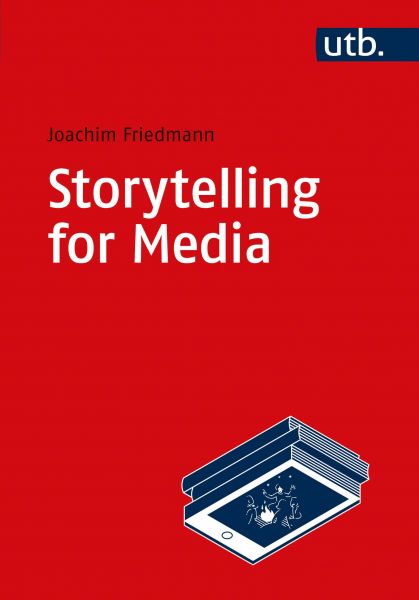Storytelling for Media
Introduction to the Theory and Practice of Narrative Design
The term "storytelling" is gaining prominence both in academia and industry — rightly so — because narrative techniques allow for particularly effective and sustainable communication. Stories are what catch our attention, move us, teach us to empathise, and create strong memories. This introduction to the strategies of storytelling uses fundamental scientific texts as well as dramaturgical guides and practical examples. Dr. Joachim Friedmann, professor and writer of scripts for tv, comics, and games, presents a both theoretically-sound and practically-applicable guide for the analysis and design of narratives in various media, not only for students, but for everyone who wants to understand how stories are created.
Joachim Friedmann ist Autor für Fernsehserien (ARD, ZDF, SAT1, RTL) sowie Comictexter (Disney, Egmont Ehapa, Carlsen Verlag) und hat zudem zahlreiche interaktive Online-Formate entwickelt, unter anderem für Microsoft Deutschland und den Deutschen Fußballbund DFB. Er lehrt an verschiedenen Universitäten und Hochschulen zum Thema interaktives und transmediales Storytelling, Serielles Schreiben sowie Film- und Fernsehdramaturgie, u.a. an der Universität Hildesheim, der Filmuniversität Potsdam-Babelsberg, der Filmakademie Baden-Württemberg und der Hamburg Media School. 2016 wurde er mit einer Arbeit zu Transmedialem Erzählen zum Dr. phil. promoviert. Seit 2017 ist er Professor für Serial Storytelling an der Internationalen Filmschule Köln.
1 Storytelling – More than Just Telling a Story
2 The Narrative Figure – Life, Theme, Function
2.1 Functional Figures
2.2 Mimetic Figures
2.3 Thematic Figures
2.4 Anti-narrative Figures
3 Setting – The Narrative Space
3.1 Juri Lotman and Semantic Space
3.2 Other Options for Spatial Semantization
3.3 Hierarchization of Spatial Events
4 Binary Narrative Oppositions – Opposites Make Sense
4.1 The Meaning of the Narrative
4.2 Production of Meaning through Binary Narrative Oppositions
4.3 Idea vs. Counter Idea – Narrative Oppositions in Film Dramaturgy
4.4 Binary Narrative Oppositions as a Structuring Principle in Serial and Interactive Narratives
5 Conflict – Obstacles Force Action
5.1 Conflicts as Initial Triggers for Action
5.2 Basic Forms of Conflict
5.3 The Universal Conflict
5.4 Conflict Types and Types of Plot
5.5 Want and Need
6 Transformation – What Needs to Change?
6.1 Transformation vs. Change
6.2 Transformation as a Criterion of Closure
6.3 The Cyclic Transformation
6.4 Transformations in Interactive Narratives
7 Emotion – Progression of Feelings
7.1 Emotions as Genres
7.2 Emotional Progression as a Structural Principle of Narratives
8 Turning Points – the Expected Surprise
8.1 Scientific Concepts of the Turning Point
8.2 The Turning Point in Applied Dramaturgy
8.3 The Effect of Turning Points in Literature and Film
8.4 Turning Points and Transformation in Interactive Narratives
9 Narrative Structure – The Hero's Journey in Three Acts
9.1 Dramatic Structure
9.2 Mythological Structure
9.3 Oral Structure
9.4 Interactive Structure
10 Causal Relationships – Why and How?
10.1 Causality as a Condition for Narrativity
10.2 Forms of Causality
10.3 Forms of Non-causal Narrative
10.4 Causality and Interactivity
11 Subtext and Gapping – Involving the Recipients
11.1 Gapping as a Text- and Media-Specific Strategy
11.2 Subtext
11.3 Generating Tension through Information Management
11.4 Information Management in Interactive Stories
12 Semantic Objects – McGuffins, Horcruxes and Holy Grails
12.1 Plot-functional vs. Non-functional
12.2 Semantic Objects in Narrative Media
12.3 The Semantization of Objects as a Communication Strategy
13 Epilogue: Values and a Worldview
14 Glossary
15 Bibliography
16 List of Figures
Versandkostenfreie Lieferung! (eBook-Download)
Als Sofort-Download verfügbar
- Artikel-Nr.: SW9783846357644110164
- Artikelnummer SW9783846357644110164
-
Autor
Joachim Friedmann
- Wasserzeichen ja
- Verlag utb.
- Seitenzahl 166
- Veröffentlichung 27.09.2021
- ISBN 9783846357644

